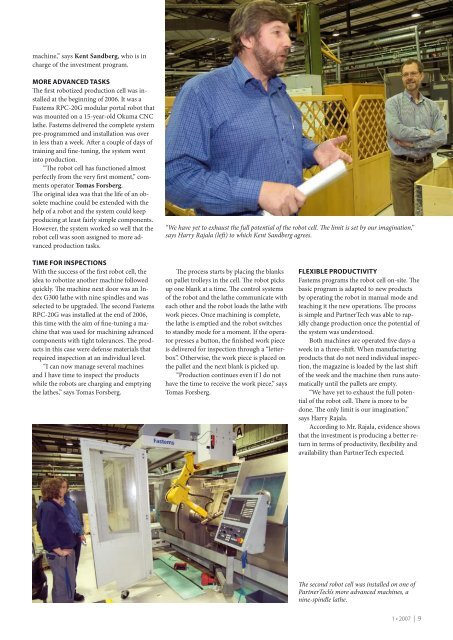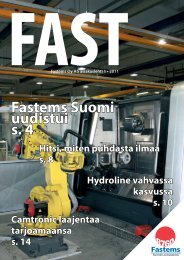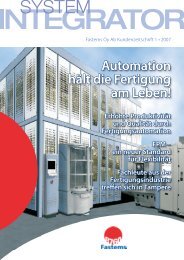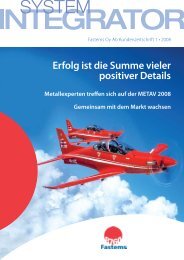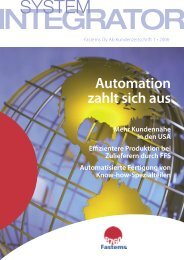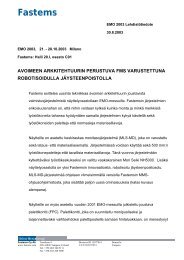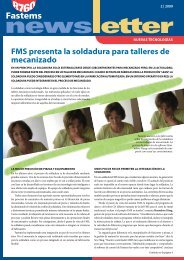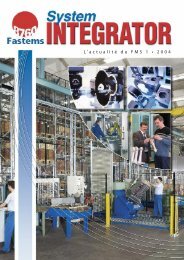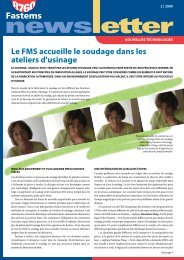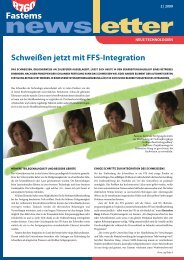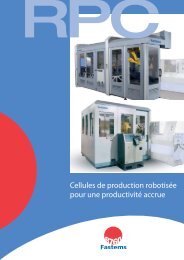Automation keeps manufacturing alive! - Fastems
Automation keeps manufacturing alive! - Fastems
Automation keeps manufacturing alive! - Fastems
You also want an ePaper? Increase the reach of your titles
YUMPU automatically turns print PDFs into web optimized ePapers that Google loves.
machine,” says Kent Sandberg, who is in<br />
charge of the investment program.<br />
more advanced tasKs<br />
The first robotized production cell was installed<br />
at the beginning of 2006. It was a<br />
<strong>Fastems</strong> RPC-20G modular portal robot that<br />
was mounted on a 15-year-old Okuma CNC<br />
lathe. <strong>Fastems</strong> delivered the complete system<br />
pre-programmed and installation was over<br />
in less than a week. After a couple of days of<br />
training and fine-tuning, the system went<br />
into production.<br />
“The robot cell has functioned almost<br />
perfectly from the very first moment,” comments<br />
operator Tomas Forsberg.<br />
The original idea was that the life of an obsolete<br />
machine could be extended with the<br />
help of a robot and the system could keep<br />
producing at least fairly simple components.<br />
However, the system worked so well that the<br />
robot cell was soon assigned to more advanced<br />
production tasks.<br />
time for inspections<br />
With the success of the first robot cell, the<br />
idea to robotize another machine followed<br />
quickly. The machine next door was an Index<br />
G300 lathe with nine spindles and was<br />
selected to be upgraded. The second <strong>Fastems</strong><br />
RPC-20G was installed at the end of 2006,<br />
this time with the aim of fine-tuning a machine<br />
that was used for machining advanced<br />
components with tight tolerances. The products<br />
in this case were defense materials that<br />
required inspection at an individual level.<br />
“I can now manage several machines<br />
and I have time to inspect the products<br />
while the robots are charging and emptying<br />
the lathes,” says Tomas Forsberg.<br />
“We have yet to exhaust the full potential of the robot cell. The limit is set by our imagination,”<br />
says Harry Rajala (left) to which Kent Sandberg agrees.<br />
The process starts by placing the blanks<br />
on pallet trolleys in the cell. The robot picks<br />
up one blank at a time. The control systems<br />
of the robot and the lathe communicate with<br />
each other and the robot loads the lathe with<br />
work pieces. Once machining is complete,<br />
the lathe is emptied and the robot switches<br />
to standby mode for a moment. If the operator<br />
presses a button, the finished work piece<br />
is delivered for inspection through a “letterbox”.<br />
Otherwise, the work piece is placed on<br />
the pallet and the next blank is picked up.<br />
“Production continues even if I do not<br />
have the time to receive the work piece,” says<br />
Tomas Forsberg.<br />
flexiBle productivity<br />
<strong>Fastems</strong> programs the robot cell on-site. The<br />
basic program is adapted to new products<br />
by operating the robot in manual mode and<br />
teaching it the new operations. The process<br />
is simple and PartnerTech was able to rapidly<br />
change production once the potential of<br />
the system was understood.<br />
Both machines are operated five days a<br />
week in a three-shift. When <strong>manufacturing</strong><br />
products that do not need individual inspection,<br />
the magazine is loaded by the last shift<br />
of the week and the machine then runs automatically<br />
until the pallets are empty.<br />
“We have yet to exhaust the full potential<br />
of the robot cell. There is more to be<br />
done. The only limit is our imagination,”<br />
says Harry Rajala.<br />
According to Mr. Rajala, evidence shows<br />
that the investment is producing a better return<br />
in terms of productivity, flexibility and<br />
availability than PartnerTech expected.<br />
The second robot cell was installed on one of<br />
PartnerTech’s more advanced machines, a<br />
nine-spindle lathe.<br />
1 • 2007 | 9


